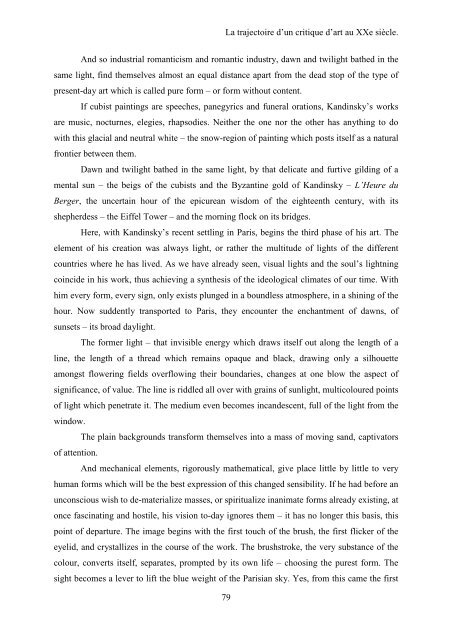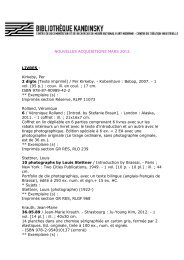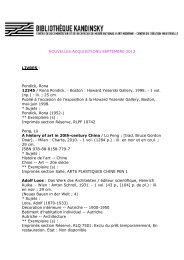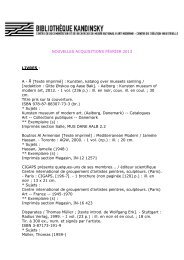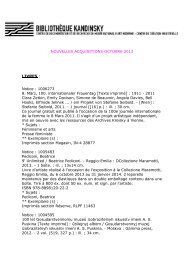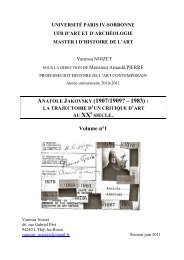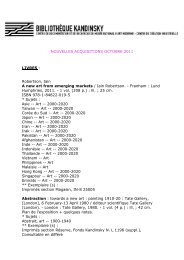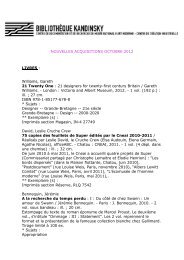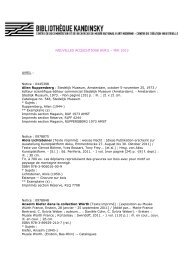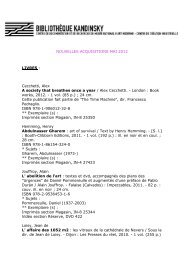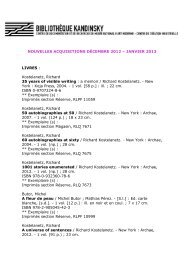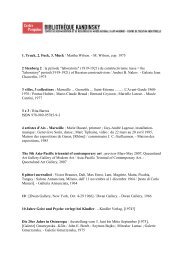anatole jakovsky (1907/1909 ? â 1983) - Bibliothèque Kandinsky
anatole jakovsky (1907/1909 ? â 1983) - Bibliothèque Kandinsky
anatole jakovsky (1907/1909 ? â 1983) - Bibliothèque Kandinsky
You also want an ePaper? Increase the reach of your titles
YUMPU automatically turns print PDFs into web optimized ePapers that Google loves.
La trajectoire d’un critique d’art au XXe siècle.<br />
And so industrial romanticism and romantic industry, dawn and twilight bathed in the<br />
same light, find themselves almost an equal distance apart from the dead stop of the type of<br />
present-day art which is called pure form – or form without content.<br />
If cubist paintings are speeches, panegyrics and funeral orations, <strong>Kandinsky</strong>’s works<br />
are music, nocturnes, elegies, rhapsodies. Neither the one nor the other has anything to do<br />
with this glacial and neutral white – the snow-region of painting which posts itself as a natural<br />
frontier between them.<br />
Dawn and twilight bathed in the same light, by that delicate and furtive gilding of a<br />
mental sun – the beigs of the cubists and the Byzantine gold of <strong>Kandinsky</strong> – L’Heure du<br />
Berger, the uncertain hour of the epicurean wisdom of the eighteenth century, with its<br />
shepherdess – the Eiffel Tower – and the morning flock on its bridges.<br />
Here, with <strong>Kandinsky</strong>’s recent settling in Paris, begins the third phase of his art. The<br />
element of his creation was always light, or rather the multitude of lights of the different<br />
countries where he has lived. As we have already seen, visual lights and the soul’s lightning<br />
coincide in his work, thus achieving a synthesis of the ideological climates of our time. With<br />
him every form, every sign, only exists plunged in a boundless atmosphere, in a shining of the<br />
hour. Now suddently transported to Paris, they encounter the enchantment of dawns, of<br />
sunsets – its broad daylight.<br />
The former light – that invisible energy which draws itself out along the length of a<br />
line, the length of a thread which remains opaque and black, drawing only a silhouette<br />
amongst flowering fields overflowing their boundaries, changes at one blow the aspect of<br />
significance, of value. The line is riddled all over with grains of sunlight, multicoloured points<br />
of light which penetrate it. The medium even becomes incandescent, full of the light from the<br />
window.<br />
The plain backgrounds transform themselves into a mass of moving sand, captivators<br />
of attention.<br />
And mechanical elements, rigorously mathematical, give place little by little to very<br />
human forms which will be the best expression of this changed sensibility. If he had before an<br />
unconscious wish to de-materialize masses, or spiritualize inanimate forms already existing, at<br />
once fascinating and hostile, his vision to-day ignores them – it has no longer this basis, this<br />
point of departure. The image begins with the first touch of the brush, the first flicker of the<br />
eyelid, and crystallizes in the course of the work. The brushstroke, the very substance of the<br />
colour, converts itself, separates, prompted by its own life – choosing the purest form. The<br />
sight becomes a lever to lift the blue weight of the Parisian sky. Yes, from this came the first<br />
79


